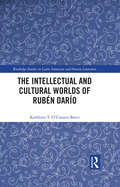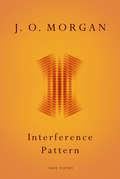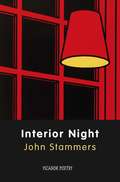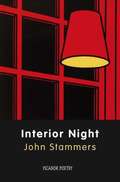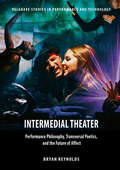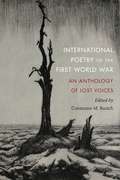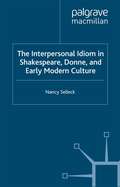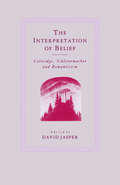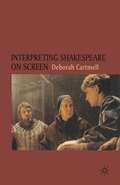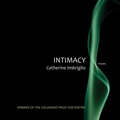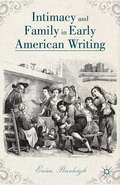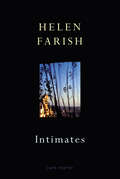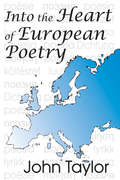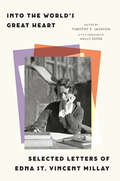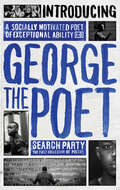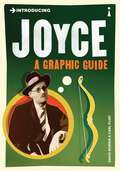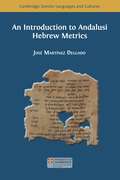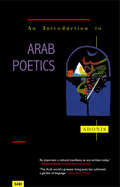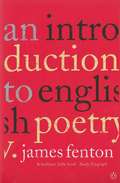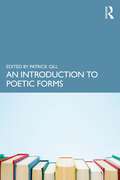- Table View
- List View
The Intellectual and Cultural Worlds of Rubén Darío (Routledge Studies in Latin American and Iberian Literature)
by Kathleen T. O’Connor-BaterNicaraguan poet Rubén Darío (1867-1916) has had a foundational influence on virtually all Spanish language writers and poets of the twentieth century and beyond. Yet, while he is a household name among Hispano-phone readers, the seminal modernista remains virtually unknown to an English readership. This book examines the writings of Ruben Dario as both poet and chronicler, as he renovates language drawing lessons from ancient mythologies to embrace the ideal of "art for art’s sake"; all the while opposing United States aggression in the hemisphere along with the pseudo-Bohemian European bourgeoisie in poetry and prose at the cusp of the Great War.
The Intellectual and Cultural Worlds of Rubén Darío (Routledge Studies in Latin American and Iberian Literature)
by Kathleen T. O’Connor-BaterNicaraguan poet Rubén Darío (1867-1916) has had a foundational influence on virtually all Spanish language writers and poets of the twentieth century and beyond. Yet, while he is a household name among Hispano-phone readers, the seminal modernista remains virtually unknown to an English readership. This book examines the writings of Ruben Dario as both poet and chronicler, as he renovates language drawing lessons from ancient mythologies to embrace the ideal of "art for art’s sake"; all the while opposing United States aggression in the hemisphere along with the pseudo-Bohemian European bourgeoisie in poetry and prose at the cusp of the Great War.
Interference Pattern
by J. O. MorganAt first, these extraordinary poems may unsettle and disturb, but the next reading could be one of rapture and astonishment; it all hinges on your point of view. Like the optical illusion of the maiden and the crone, you can only see one image at a time; the brain deciding which is the figure and which the background. It is a book that acts out its own subjects – dualities, ambiguities, boundaries – through physical dislocation, through patterns of interference.This is a collage of many voices: eager or dispassionate, unreliable or matter-of-fact – depending, as with everything else, on your angle of entry. Some of the voices fear involvement; some are afraid of doing nothing; some, perhaps, have already gone too far. Like the image on the cover, these pieces shimmer and buzz in their own instability. Is this punishment or reward? What is the yellow smoke? Will there be bodies floating under the plastic pool-cover? Are we, like the hotel manager, seeing visions?Volatile, troubling, but endlessly interesting, these poems show J. O. Morgan working and compressing language into a precarious, frictional state. As a result, Interference Pattern is a unique reading experience: vivid, challenging and completely original.
Interior Night
by John StammersJohn Stammers has a poetic mind original enough to read the most mundane and familiar events as great portents and wonders, and an eye clear enough to uncover the surreal when it’s right under our noses. Stammers’ third collection is a vast map of an imaginative space that coincides with the known world, but radically changes the way we perceive it. Interior Night sees a restlessly eclectic mind engaged with the whole range of human creation, from our cultural icons to our cultural detritus. There are also dramatic monologues from the dark worlds of poverty and addiction, as well as typically unsettling run-ins with the shades of Rimbaud, Sterne and Keats. Stammers has focused all his celebrated daring and oblique strategie to produce a book of great emotional candour and seriousness.
Interior Night (PDF)
by John StammersJohn Stammers has a poetic mind original enough to read the most mundane and familiar events as great portents and wonders, and an eye clear enough to uncover the surreal when it’s right under our noses. Stammers’ third collection is a vast map of an imaginative space that coincides with the known world, but radically changes the way we perceive it. Interior Night sees a restlessly eclectic mind engaged with the whole range of human creation, from our cultural icons to our cultural detritus. There are also dramatic monologues from the dark worlds of poverty and addiction, as well as typically unsettling run-ins with the shades of Rimbaud, Sterne and Keats. Stammers has focused all his celebrated daring and oblique strategie to produce a book of great emotional candour and seriousness.
Intermedial Theater: Performance Philosophy, Transversal Poetics, and the Future of Affect (Palgrave Studies in Performance and Technology)
by Bryan ReynoldsThis book explores relationships between intermedial theater, consciousness, memory, objects, subjectivity, and affect through productive engagement with the performance aesthetics, socio-cognitive theory, and critical methodology of transversal poetics alongside other leading philosophical approaches to performance. It offers the first sustained analysis of the work of Gilles Deleuze, Félix Guattari, Jean Baudrillard, and Friedrich Nietzsche in relation to the contemporary European theater of Jan Lauwers and Needcompany, Romeo Castellucci and Socìetas Raffaello Sanzio, Thomas Ostermeier, Rodrigo García and La Carnicería Teatro, and the Transversal Theater Company. It connects contemporary uses of objects, simulacra, and technologies in both posthumanist discourse and postdramatic theater to the transhistorically and culturally mediating power of Shakespeare as a means by which to discuss the affective impact of intermedial theater on today’s audiences.
International Poetry of the First World War: An Anthology of Lost Voices
by Constance RuzichRanging far beyond the traditional canon, this ground-breaking anthology casts a vivid new light on poetic responses to the First World War. Bringing together poems by soldiers and non-combatants, patriots and dissenters, and from all sides of the conflict across the world, International Poetry of the First World War reveals the crucial public role that poetry played in shaping responses to and the legacies of the conflict. Across over 150 poems, this anthology explores such topics as the following: · Life at the Front · Psychological trauma · Noncombatants and the home front · Rationalising the war · Remembering the dead · Peace and the aftermath of the war With contextual notes throughout, the book includes poems written by authors from America, Australia, Austria-Hungary, Belgium, Canada, France, Germany, Great Britain, India, Ireland, Italy, New Zealand, Russia, and South Africa.
International Poetry of the First World War: An Anthology of Lost Voices
Ranging far beyond the traditional canon, this ground-breaking anthology casts a vivid new light on poetic responses to the First World War. Bringing together poems by soldiers and non-combatants, patriots and dissenters, and from all sides of the conflict across the world, International Poetry of the First World War reveals the crucial public role that poetry played in shaping responses to and the legacies of the conflict. Across over 150 poems, this anthology explores such topics as the following: · Life at the Front · Psychological trauma · Noncombatants and the home front · Rationalising the war · Remembering the dead · Peace and the aftermath of the war With contextual notes throughout, the book includes poems written by authors from America, Australia, Austria-Hungary, Belgium, Canada, France, Germany, Great Britain, India, Ireland, Italy, New Zealand, Russia, and South Africa.
The Interpersonal Idiom in Shakespeare, Donne, and Early Modern Culture
by N. SelleckThe Interpersonal Idiom offers a timely reformulation of identity in the age of Shakespeare, recovering a rich and now obsolete language that casts selfhood not as subjective experience but as the experience of others.
Interpreting Shakespeare on Screen
by Hester BradleyThis book explores Shakespeare films as interpretations of Shakespeare's plays as well as interpreting the place of Shakespeare on screen within the classroom and within the English curriculum. Shakespeare on screen is evaluated both in relation to the play texts and in relation to the realms of popular film culture. The book focuses on how Shakespeare is manipulated in film and television through the representation of violence, gender, sexuality, race and nationalism. Cartmell discusses a wide range of films, including Orson Welles' Othello (1952), Kenneth Branagh's Much Ado About Nothing (1993), Peter Greenaway's Prospero's Books (1991), Baz Luhrmann's William Shakespeare's Romeo and Juliet (1996) and John Madden's Shakespeare in Love (1998).
Interpreting Shakespeare on Screen
by Hester BradleyThis book explores Shakespeare films as interpretations of Shakespeare's plays as well as interpreting the place of Shakespeare on screen within the classroom and within the English curriculum. Shakespeare on screen is evaluated both in relation to the play texts and in relation to the realms of popular film culture. The book focuses on how Shakespeare is manipulated in film and television through the representation of violence, gender, sexuality, race and nationalism. Cartmell discusses a wide range of films, including Orson Welles' Othello (1952), Kenneth Branagh's Much Ado About Nothing (1993), Peter Greenaway's Prospero's Books (1991), Baz Luhrmann's William Shakespeare's Romeo and Juliet (1996) and John Madden's Shakespeare in Love (1998).
Intimacy (Colorado Prize for Poetry)
by Catherine ImbriglioWinner of the 2013 Colorado Prize for Poetry Intimacy is a series of experimental poems that play with, resist, and acknowledge complicity with received concepts of intimacy that circulate in this media-centric age. Undertaking an expansive understanding of the word “intimacy”, each poem contains a word or set of words that modifies the noun, uncovering the attending, associative and often contradictory obligations that arise in our relations with one another.
Intimacy and Family in Early American Writing
by E. BurleighThrough the prism of intimacy, Burleigh sheds light on eighteenth and early-nineteenth-century American texts. This insightful study shows how the trope of the family recurred to produce contradictory images - both intimately familiar and frighteningly alienating - through which Americans responded to upheavals in their cultural landscape.
Intimates
by Helen FarishProvocative and tender, passionate yet wary, the highly charged poems in Helen Farish's first collection testify to the complex nature of relationships with lovers, with family and with the self. The love poems explore moments of intense exposure, and within the erotic relation seek to carve out a voice adequate to the expression of female sexuality and desire. Within this framework, the body itself becomes a rich and compelling site of inquiry. Posted throughout the collection like sentinels, poems on the death of the father draw the poet back home where grief mingles with surprising moments of grace or redemption. But whether the encounter concerns sudden loss or sudden blessing, constant throughout is a warm and boldly embodied lyric 'I' voice generously inviting the reader in. Poised at life's mid-point, these haunting, haunted poems negotiate their emotional freight in carefully crafted forms which mediate between exposure and guardedness. Expertly charting the geographies of sex and love, the histories of childhood and grief, Intimates introduces a new poet of originality, honesty and singular power.
Into the Heart of European Poetry
by John TaylorJohn Taylor's brilliant new book examines the work of many of the major poets who have deeply marked modern and contemporary European literature. Venturing far and wide from the France in which he has lived since the late 1970s, the polyglot writer-critic not only delves into the more widely translated literatures of Italy, Greece, Germany, and Austria, but also discovers impressive and overlooked work in Slovenia, Bosnia, Hungary, Finland, Norway, and the Netherlands in this book that ranges over nearly all of Europe, including Russia.While providing this stimulating and far-ranging critical panorama, Taylor brings to light key themes of European writing: the depth of everyday life, the quest of the thing-in-itself, metaphysical aspiration and anxiety, the dialectics of negativity and affirmation, subjectivity and self-effacement, and uprootedness as a category that is as ontological as it is geographical, historical, political, or cultural. The book pays careful attention to the intersection of writing and history (or politics), as several poets featured here have faced the Second World War, the Holocaust, Communism, the fall of Communism, or the war in the former Yugoslavia.Taylor gives the work of renowned, upcoming, and still little-known poets a thorough look, all the while scrutinizing recent translations of their verse. He highlights several poets who are also masters of the prose poem. He includes a few novelists who have fashioned a particularly original kind of poetic prose, that stylistic category that has proved so difficult for critics to define. Into the Heart of European Poetry should be of immediate interest to any reader curious about the aesthetic and philosophical ideas underlying major trends of contemporary European writing. In a day and age when much too little is translated and thus known about foreign literature, and when Europeans themselves are pondering the common denominators of their own culture, this book is a
Into the Heart of European Poetry
by John TaylorJohn Taylor's brilliant new book examines the work of many of the major poets who have deeply marked modern and contemporary European literature. Venturing far and wide from the France in which he has lived since the late 1970s, the polyglot writer-critic not only delves into the more widely translated literatures of Italy, Greece, Germany, and Austria, but also discovers impressive and overlooked work in Slovenia, Bosnia, Hungary, Finland, Norway, and the Netherlands in this book that ranges over nearly all of Europe, including Russia.While providing this stimulating and far-ranging critical panorama, Taylor brings to light key themes of European writing: the depth of everyday life, the quest of the thing-in-itself, metaphysical aspiration and anxiety, the dialectics of negativity and affirmation, subjectivity and self-effacement, and uprootedness as a category that is as ontological as it is geographical, historical, political, or cultural. The book pays careful attention to the intersection of writing and history (or politics), as several poets featured here have faced the Second World War, the Holocaust, Communism, the fall of Communism, or the war in the former Yugoslavia.Taylor gives the work of renowned, upcoming, and still little-known poets a thorough look, all the while scrutinizing recent translations of their verse. He highlights several poets who are also masters of the prose poem. He includes a few novelists who have fashioned a particularly original kind of poetic prose, that stylistic category that has proved so difficult for critics to define. Into the Heart of European Poetry should be of immediate interest to any reader curious about the aesthetic and philosophical ideas underlying major trends of contemporary European writing. In a day and age when much too little is translated and thus known about foreign literature, and when Europeans themselves are pondering the common denominators of their own culture, this book is a
Into the World’s Great Heart: Selected Letters of Edna St. Vincent Millay
by Edna St. MillayAn annotated selection of the letters of the Pulitzer Prize–winning poet and playwright Edna St. Vincent Millay, from childhood through the last year of her life Throughout her life, Edna St. Vincent Millay wrote hundreds of letters, which together create a colorful tapestry of her inner life. This selection, based on archival research, represents Millay’s correspondence from 1900, when she was eight, until 1950, the last year of her life. Through her letters, readers encounter the vast range of Millay’s interests, including world literature, music, and horse racing, as well as her commitment to gender equality and social justice. This collection, edited by Timothy F. Jackson, includes previously unpublished correspondence, as well as letters containing early versions of poems, revealing new dimensions in Millay’s creative process and influences. It is enriched by Jackson’s thoughtful introduction and notes, plus a foreword by Millay’s literary executor, Holly Peppe. Millay’s observations on her inner life and the world around her—which speak to contemporary concerns as well—add to our understanding of American literature in the first half of the twentieth century.
Introducing George The Poet: Search Party: A Collection of Poems
by George The Poet‘The title is Search Party – the idea being that we’re all out here looking for something, and my poems are my way of finding myself.’ A young black poet blending spoken word and rap; an inner city upbringing with a Cambridge education; a social consciousness with a satirical wit and infectious rhythm – George The Poet is the voice of a new generation.Search Party is a thought-provoking and deeply autobiographical collection. From the overtly political ‘Go Home’ to the deeply personal ‘Full-time’; the narrative poems that offer vivid and unapologetic snapshots of inner-city life, such as ‘His Mistakes’, ‘Believer’ and the anthemic ‘My City’; to the provocative social commentary in ‘Lazy Dog’ and ‘YOLO’; to the inspiring, idea-driven pieces such as ‘The Power of Collaboration’ and ‘School Blues’, George takes poetry into new territories and to new audiences, offering a different way to talk about the things that matter, to explore his own experience and ideas, and encourage others explore theirs.George The Poet’s mesmerising and unforgettable live performances have earned him critical acclaim. From sell-out headline gigs and YouTube hits, to recording his own music, and now his first collection of poetry, George uses his work to speak truth to power and challenge our preconceived ideas about the society we’re living in.Whether you’re searching for yourself, for answers, for change – join the search party.
Introducing Joyce: A Graphic Guide (Introducing...)
by David NorrisJames Joyce is one of the most famous--and controversial--writers of the twentieth century. The myth of his difficulty has discouraged many readers from works such as "Ulysses," but David Norris explores his life and work in this engaging and intellectually rigorous introduction.
Introduction to a Poetics of Diversity: by Édouard Glissant (The Glissant Translation Project #1)
by Celia BrittonThis book reproduces the texts of four lectures, followed by discussions, and two interviews with Lise Gauvin published in Introduction à une poétique du divers (1996); and also four further interviews from L’Imaginaire des langues (Lise Gauvin, 2010). It covers a wide range of topics but key recurring themes are creolization, language and langage, culture and identity, ‘monolingualism’, the ‘Chaos-world’ and the role of the writer. Migration and the various different kinds of migrants are also discussed, as is the difference between ‘atavistic’ and ‘composite’ communities, the art of translation, identity as a ‘rhizome’ rather than a single root, the Chaos-World and chaos theory, ‘trace thought’ as opposed to ‘systematic thought’, the relation between ‘place’ and the Whole-World, exoticism, utopias, a new definition of beauty as the realized quantity of differences, the status of literary genres and the possibility that literature as a whole will disappear. Four of the interviews (Chapters 6, 7, 8 and 9) relate to particular works that Glissant has published: Tout-monde, Le monde incrée, La Cohée du Lamentin, Une nouvelle région du monde. Many of these themes have been explored in his previous works, but here, because in all the chapters we see Glissant interacting with the questions and views of other people, they are presented in a particularly accessible form.
An Introduction to Andalusi Hebrew Metrics: (pdf)
by José Martínez DelgadoThroughout the last two centuries, Hebrew metrics was studied by leading linguists and specialists in medieval Hebrew poetry. Nowadays, it has disappeared from the academic discussion such that it is sometimes even difficult to find scansions or the name of the meter in new editions of poems. This book aims to rectify this gap, helping readers to understand the metric structure of this poetry in order to facilitate the work of editing and cataloguing those samples still in manuscript form for future editors. Delgado presents his view of Andalusi Hebrew metrics, as encountered in medieval manuals of Arabic and Hebrew metrics and scattered notes in the works of Andalusi Hebrew philologists. Whilst twentieth-century scholars spoke about the adaptation of Arabic metrics to Hebrew, he instead approaches these compositions by Andalusi Jews (10th-13th c.) as Arabic metrics written in Hebrew, thus emphasising how Hebrew poetry of the Andalusi Jews can help us to understand the general evolution of Arabic strophic poetry, and its experimental evolution, which is quite unlike classical and strophic Arabic poetry. This method respects the Hebrew vowel system, and does not necessitate alteration of word morphology, leaving the guttural letters quiescent (unless required by metrical license); nor does it necessitate guesses about metres that are not in the classical catalogue. Although the author has not found each and every classical metre from Andalusi Hebrew poetry included in this manual, they are all catalogued, either in case someone finds them in future or because they help us to comprehend the metrical structures that are characteristic of strophic poetry. As such, this monograph will be of great interest to scholars of Hebrew metrics.
An Introduction to Arab Poeti
by AdonisPoetry is the quintessence of Arab culture. In this book, one of the foremost Arab poets reinterprets a rich and ancient heritage. He examines the oral tradition of pre-Islamic Arabian poetry, as well as the relationship between Arabic poetry and the Qur'an, and between poetry and thought. Adonis also assesses the challenges of modernism and the impact of western culture on the Arab poetic tradition. Stimulating in their originality, eloquent in their treatment of a wide range of poetry and criticism, these reflections open up fresh perspectives on one of the world's greatest - and least explored - literatures. 'The most intellectually stimulating of several Arab books of unique literary distinction in fine translations ... Translated with uncommon intelligence ... As important a cultural manifesto as any written today.' Edward Said, Independent on Sunday 'Adonis's only prose work available in English is this book. The loss is ours and it is massive, for Adonis is a writer like Neruda or Marquez.' Geoff Dyer, Independent 'Introduces the reader to a new way of interpreting all poetry, and to many marvellous words that do not have an English equivalent.' Arts Letter
An Introduction to English Poetry
by James FentonJames Fenton's An Introduction to English Poetry offers a master class for both the reader and writer of poetry. Simply and elegantly written and discussing the work of poets as wide ranging as W. H. Auden, Dylan Thomas, Tennyson, Kipling, Milton and Blake, it covers all varieties of poetic practice in English.'It is hard to imagine a beginner who could not learn from [this book]. If you know a young poet, give them this' The Times Literary Supplement
An Introduction to Poetic Forms
by Patrick GillAn Introduction to Poetic Forms offers specimen discussions of poems through the lens of form. While each of its chapters does provide a standard definition of the form in question in its opening paragraphs, their main objective is to provide readings of specific examples to illustrate how individual poets have deviated from or subverted those expectations usually associated with the form under discussion. While providing the most vital information on the most widely taught forms of poetry, then, this collection will very quickly demonstrate that counting syllables and naming rhyme schemes is not the be-all and end-all of poetic form. Instead, each chapter will contain cross-references to other literary forms and periods as well as make clear the importance of the respective form to the culture at large: be it the democratising communicative power of the ballad or the objectifying male gaze of the blazon and resistance to same in the contreblazon – the efficacy of form is explored in the fullness of its cultural dimensions. In using standard definitions only as a starting point and instead focusing on lively debates around the cultural impact of poetic form, the textbook helps students and instructors to see poetic forms not as a static and lifeless affair but as living, breathing testament to the ongoing evolution of cultural debates. In the final analysis, the book is interested in showing the complexities and contradictions inherent in the very nature of literary form itself: how each concrete example deviates from the standard template while at the same time employing it as a foil to generate meaning.
